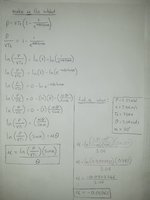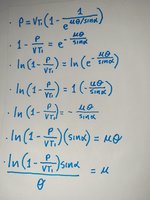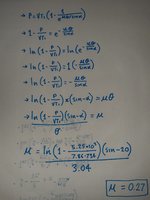You are using an out of date browser. It may not display this or other websites correctly.
You should upgrade or use an alternative browser.
You should upgrade or use an alternative browser.
Have I done this correctly?
- Thread starter Sabi
- Start date
D
Deleted member 4993
Guest
In the 3rd line you have taken "Ln" separately - that was illegal operation You could take the "Ln" of the whole Right-hand-side - but that don't take you closer to solution. Instead you should do following:Hey all,
Have I gone wrong somewhere in this transposition/final equation, seems way overkill to get there.
Plus the final result came out negative when I thought it should be a positive value? (Friction coefficient)
Any advice would be great.
\(\displaystyle \frac{P}{VT_1} \ = \ 1 - \ e^{-\frac{\mu \theta }{sin( \alpha )}}\)l
\(\displaystyle 1 - \ \frac{P}{VT_1} \ = \ e^{-\frac{\mu \theta }{sin( \alpha )}}\)
\(\displaystyle ln \left[ 1 - \ \frac{P}{VT_1} \right] \ = \ ln \left[ e^{-\frac{\mu \theta }{sin( \alpha )}} \right] \)
continue......
In the 3rd line you have taken "Ln" separately - that was illegal operation You could take the "Ln" of the whole Right-hand-side - but that take you closer to solution. Instead you should do following:
\(\displaystyle \frac{P}{VT_1} \ = \ 1 - \ e^{-\frac{\mu \theta }{sin( \alpha )}}\)
\(\displaystyle 1 - \ \frac{P}{VT_1} \ = \ e^{-\frac{\mu \theta }{sin( \alpha )}}\)
\(\displaystyle ln \left[ 1 - \ \frac{P}{VT_1} \right] \ = \ ln \left[ e^{-\frac{\mu \theta }{sin( \alpha )}} \right] \)
continue......
Thanks for your reply, I will have another go with that correction. Am I wrong in thinking that line 5 onwards the right side will not change a great deal? A little bit confused.
D
Deleted member 4993
Guest
Show your work according to your understanding and we will discuss further.Thanks for your reply, I will have another go with that correction. Am I wrong in thinking that line 5 onwards the right side will not change a great deal? A little bit confused.
Show your work according to your understanding and we will discuss further.
Here's what I came up with.
Attachments
D
Deleted member 4993
Guest
Looks good to me.Here's what I came up with.
Looks good to me.
I think I have made a mistake still as my answer is still coming out negative. Coefficient of friction should always be positive right?
Now for a final answer I'm getting -0.2709
Could it be an error where I should have used (-sinx)
I think I have made a mistake still as my answer is still coming out negative. Coefficient of friction should always be positive right?
Now for a final answer I'm getting -0.2709
Could it be an error where I should have used (-sinx)
Edit:
I made an error in my calculation (but it's still a negative result) final answer from the equation coming out at -2.857×10^-3

Dr.Peterson
Elite Member
- Joined
- Nov 12, 2017
- Messages
- 16,861
You dropped a negative sign at the next to last line.Here's what I came up with.
You dropped a negative sign at the next to last line.
Yes I was pretty sure that was the problem. What's confusing me is I'm almost certain the final solution is positive 2.857×10^-3 but I cant seem to get there?
Dr.Peterson
Elite Member
- Joined
- Nov 12, 2017
- Messages
- 16,861
Yes I was pretty sure that was the problem. What's confusing me is I'm almost certain the final solution is positive 2.857×10^-3 but I cant seem to get there?
Well, when you put the sign back in, that's what you get, right?
Except that in your calculation, you somehow have P^3 rather than just P! So your calculation is wrong.
Now fix your answer and put it into the original equation and see it it's true. If so, then you can be entirely certain that it is the solution!
D
Deleted member 4993
Guest
You were told that you had dropped a "negative" sign. Did you fix that?Yes I was pretty sure that was the problem. What's confusing me is I'm almost certain the final solution is positive 2.857×10^-3 but I cant seem to get there?
You were told that you had dropped a "negative" sign. Did you fix that?
I did have a go. Whether it's right or not is another matter.
Attachments
Dr.Peterson
Elite Member
- Joined
- Nov 12, 2017
- Messages
- 16,861
I did have a go. Whether it's right or not is another matter.
I see this time that you took [MATH]P = 5.25\times 10^3[/MATH], and I see that you did that in your original work, too. I suppose that must be right; but you never told us how the variables in the original equation are defined, which is why I assumed it should just be 5.25. Evidently P is in watts, and P is 5.25 kilowatts?
In that case, I, too, get [MATH]\mu = 0.27[/MATH]. Did you try checking it in the original equation?
I see this time that you took [MATH]P = 5.25\times 10^3[/MATH], and I see that you did that in your original work, too. I suppose that must be right; but you never told us how the variables in the original equation are defined, which is why I assumed it should just be 5.25. Evidently P is in watts, and P is 5.25 kilowatts?
In that case, I, too, get [MATH]\mu = 0.27[/MATH]. Did you try checking it in the original equation?
The values/units for each variable are in post #1 but sorry about that I should have included in the rest.
Plugged the final value and it does check out.
I was unsure if how I moved the negative sign was legal. e.g flipping the exponent to get sin(-x) on the left side.
Thanks very much guys. I do really appreciate it.
Sabi x
Dr.Peterson
Elite Member
- Joined
- Nov 12, 2017
- Messages
- 16,861
What you said was that P = 5.25 kW, without saying explicitly that P is defined as in watts, not kW. But it was implied by your work.The values/units for each variable are in post #1 but sorry about that I should have included in the rest.
I would not have moved the negative inside the sine, though it's not wrong (since the sine is an odd function). I would have just put a "-" to the left of the whole expression, since you multiplied by -1 and by [MATH]\sin(\alpha)[/MATH].I was unsure if how I moved the negative sign was legal. e.g flipping the exponent to get sin(-x) on the left side.



